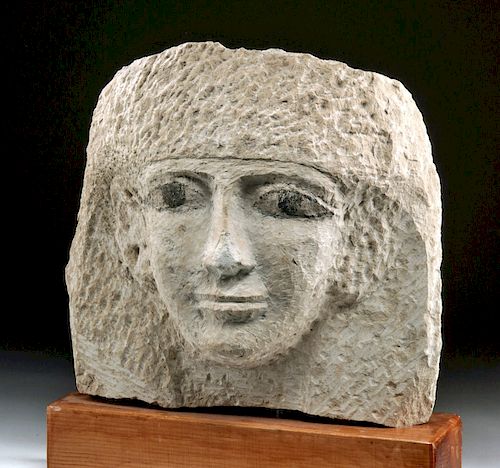Huge Egyptian Limestone Coffin Lid w/ Face
Lot 8
About Seller
Artemis Fine Arts
686 S Taylor Ave, Ste 106
Louisville, CO 80027
United States
Selling antiquities, ancient and ethnographic art online since 1993, Artemis Gallery specializes in Classical Antiquities (Egyptian, Greek, Roman, Near Eastern), Asian, Pre-Columbian, African / Tribal / Oceanographic art. Our extensive inventory includes pottery, stone, metal, wood, glass and textil...Read more
Estimate:
$10,000 - $15,000
Absentee vs Live bid
Two ways to bid:
- Leave a max absentee bid and the platform will bid on your behalf up to your maximum bid during the live auction.
- Bid live during the auction and your bids will be submitted real-time to the auctioneer.
Bid Increments
| Price | Bid Increment |
|---|---|
| $0 | $25 |
| $300 | $50 |
| $1,000 | $100 |
| $2,000 | $250 |
| $5,000 | $500 |
| $10,000 | $1,000 |
| $20,000 | $2,500 |
| $50,000 | $5,000 |
| $100,000 | $10,000 |
| $200,000 | $20,000 |
About Auction
By Artemis Fine Arts
Sep 26, 2019
Set Reminder
2019-09-26 10:00:00
2019-09-26 10:00:00
America/New_York
Bidsquare
Bidsquare : Exceptional Day 1: Antiquities & Asian Art
https://www.bidsquare.com/auctions/artemis-gallery/exceptional-day-1-antiquities-asian-art-4437
Day 1 of an important 2-day auction featuring exceptional, museum-worthy examples of Egyptian, Greek, Etruscan, Roman, Viking, Russian, Near Eastern, as well as Asian Art from China, Japan, Thailand, Vietnam, Burma and India. Artemis Fine Arts info@artemisfinearts.com
Day 1 of an important 2-day auction featuring exceptional, museum-worthy examples of Egyptian, Greek, Etruscan, Roman, Viking, Russian, Near Eastern, as well as Asian Art from China, Japan, Thailand, Vietnam, Burma and India. Artemis Fine Arts info@artemisfinearts.com
- Lot Description
Egypt, Late Dynastic to Ptolemaic period, ca. 664 to 30 BCE. An enormous coffin lid, hand-carved from soft white limestone, in the form of a stylized human head. The colossal countenance presents with sensitive, wide-set, almond-shaped eyes peering out at the viewer from beneath gently curved brows, a smooth nose with flared nostrils, high cheek bones above a rounded chin, and full lips with a grooved philtrum, and cupped ears, all beneath the folds of a simple bag wig. The pupils and eye lid outlines are accentuated with applied jet-black pigment that stands in stark contrast to the stone's milky hue. Coffin lids carved from stone like this example were carved by sculptors commissioned by families who could afford higher quality materials but perhaps not finer mediums like hardwoods, gilding, and polychrome pigments. Size: 16.625" W x 15.75" H (42.2 cm x 40 cm); 19.25" H (48.9 cm) on included custom stand.
Another comparable example, though with pigmentation, was featured at Sotheby's New York (8 December 2015), lot 27 with a $200,000 to $300,000 estimate. A catalogue note reads, "Cf. Sue D'Auria, Peter Lacovara, and Catharine H. Roehrig, Mummies & Magic, The Funerary Arts of Ancient Egypt, Boston, 1988, p. 193, no. 139, for a similar sarcophagus mask slightly later in date. The author writes that it "belongs to a class that evolved in Dynasty 30, and continued in use well into the Ptolemaic Period. Some dated examples were found by Petrie in Cemetery B at Abydos, belonging to Dynasty 30, and later sarcophagi of the same type are recorded from Qau and Akhmim. They usually bear inscriptions down the front in vertical columns, and additional decoration could be provided at the sides in the form of representations of the Four Sons of Horus or other funerary deities. Large wesekh-collars with falcon-headed terminals are also a feature of certain examples of this type of sarcophagus. Many uninscribed sarcophagi of this shape and material are known; they may be unfinished, or the painted decoration has not survived."
Provenance: private J.H. collection, Beaverton, Oregon, USA; ex-Relics of the Nile, Lexington, Kentucky, USA; ex-private S.O. Simonian collection, Switzerland
All items legal to buy/sell under U.S. Statute covering cultural patrimony Code 2600, CHAPTER 14, and are guaranteed to be as described or your money back.
A Certificate of Authenticity will accompany all winning bids.
We ship worldwide and handle all shipping in-house for your convenience.
#149584Repaired from multiple large pieces, with chips and light adhesive residue along break lines. Abrasions and nicks to obverse, nose, peripheries, and verso as shown, with light fading to original pigmentation, and light encrustations. Great earthen deposits throughout.Condition
- Shipping Info
-
All shipping is handled in-house for your convenience. Your invoice from Artemis Gallery will include shipping calculation instructions. If in doubt, please inquire BEFORE bidding for estimated shipping costs for individual items.
-
- Buyer's Premium



 EUR
EUR CAD
CAD AUD
AUD GBP
GBP MXN
MXN HKD
HKD CNY
CNY MYR
MYR SEK
SEK SGD
SGD CHF
CHF THB
THB














